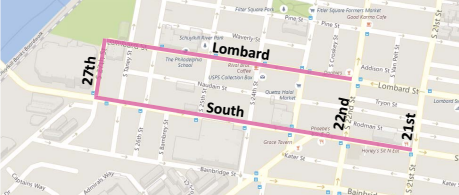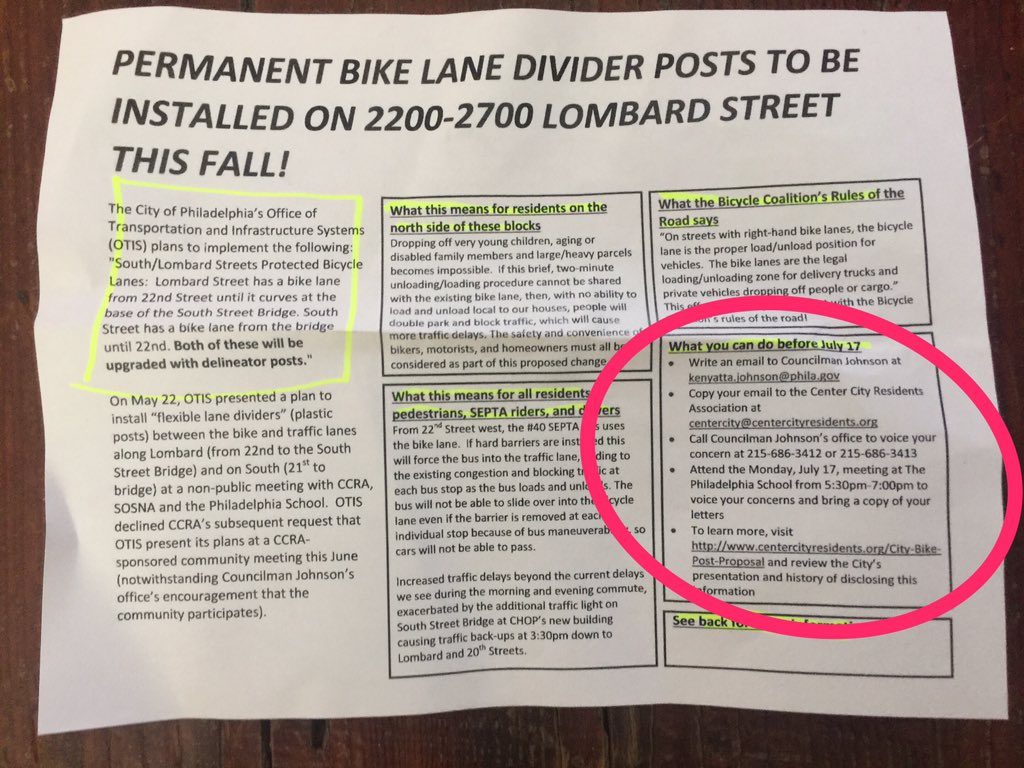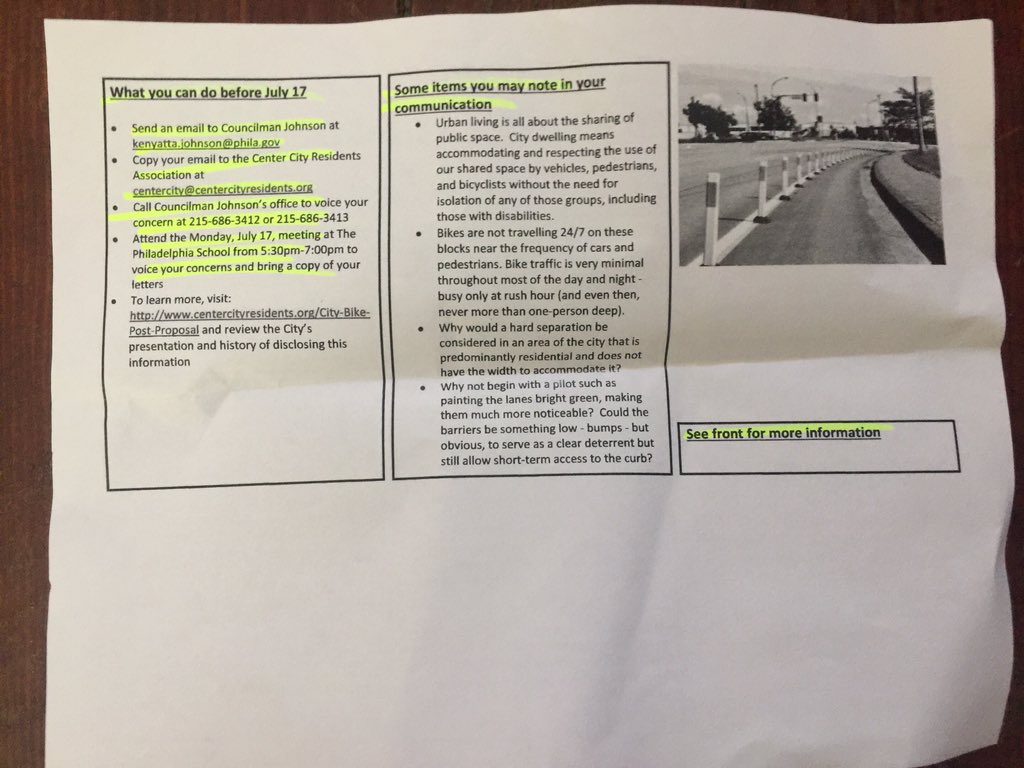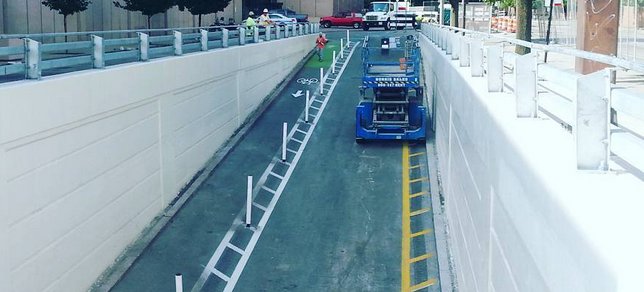
Proposed protected bike lanes in Southwestern Center City
Editorial Note: Center City Residents Association made it clear to us in an email received this afternoon that the flyers in question were not created by CCRA, they were not approved by CCRA, and they were not handed out by anyone acting on the authority of CCRA.
In anticipation of a July 17 meeting to discuss protected bike lanes in Center City, someone has created and distributed fliers with fake, misleading information meant to scare residents and, ultimately, undermine proposed safety enhancements for pedestrians and people who ride bicycles.
These fliers are part of a pattern of successful misinformation campaigns directed at no-brainer safety improvements for Philadelphia’s streets.
These fliers came to our attention from Twitter user DeWitt Brown.


Before I get into why the new fliers are dangerous, it’s important to know how this has been done before. Successfully.
Leading up to a Washington West meeting about protected bike lanes late last year, someone shared similar fliers claiming protected bike lanes would block ambulances from traveling on Spruce and Pine Streets.

This was false. But it didn’t matter. Using examples like impugning an ambulance intentionally triggers an emotional response, and has the power to make a person reading about it for the first time to react negatively.
Of course no one wants to actively deny a sick person access to their care. And protected bike lanes would not/cannot do that. But when you use examples like that one (and new ones being used in the current round of fliering, which I will get to), facts matter less to some, and don’t matter at all to others.
Case in point: Outrage™ over that fake information resulted in shelving protected bike lanes on Spruce and Pine for the time being, which delays added safety for bicyclists on Philadelphia’s most-ridden streets.
This is not uncommon for 2017. Fake news has penetrated, and appropriated, the lexicon of ideas. Someone’s feelings on a subject—based on what they heard either from a political website owned by Macedonian teenagers, or an anonymous flier based on nothing—is often more important than reality.
But nevertheless, when these issues come up, it’s crucial we have an honest debate.
The Bicycle Coalition of Greater Philadelphia’s goal is safety for everyone on the streets. We believe, based on evidence, that protected bike lanes do that. If they didn’t, we would not support them. We also believe—based on evidence!—that protected bike lanes do not impede living situations for anyone near them, but actually create more safety for everyone.
So, once again, I’m going through some false information and attempting to correct it.
But know this: The sorts of people who wrote, and who would believe, this sort of flier, don’t care about facts. That’s why we encourage you to come out to the meeting on July 17 at the Philadelphia School, being organized by the City’s Office of Transportation and Infrastructure Systems to discuss protected bike lanes in west Center City.
Claim: “[With the installation of bollards], Dropping off very young children, aging or disabled family members and large/heavy parcels becomes impossible.”

Construction happening on the 5th Street Tunnel
The point of bollards like the ones being discussed now are to minimize parking in bike lanes for convenience, not to deny access to children, the elderly or a person with disabilities.
It makes the most sense to install additional loading zones on streets where bike lanes already exist and will be enhanced with flexible plastic bollards.
While it’s possible to pull over in a bike lane with or without bollards, overall safety would be enhanced for everyone if motor vehicles and bicyclists were not competing over the same space. More loading zones and handicapped parking spaces are the answer; not pulling over in a bike lane.
And all that said, creating a situation and place where children feel comfortable riding their bicycles to school instead of getting dropped off is good for everyone.
Claim: “Permanent Bike Lane Divider Posts to be Installed on 2200-2700 Lombard Street This Fall!”
The anonymous writer of this flier either knows something the Office of Transportation and Infrastructure Systems and Philadelphia City Council does not know, or has created a timeline out of thin air.
Trying to figure out which one it could be…
Many steps – about 20 in all – have to be considered before a bike lane gets installed anywhere in the city, and when I reached out to OTIS about this timeline, they noted, “The Fall timeline is not correct. There are many issues to resolve and the Listening Session comes first before we determine a timeline.”
So, while the flier may be correct in its fall timeline, there is no evidence yet to suggest these flexible bollards will be installed in the fall.
Not to mention: Calling a flexible delineator post that is screwed into the ground with four screws “permanent” is pretty disingenuous.
Claim: “…buses will not be able to slide over into the bicycle lane even if the barrier is removed at each individual stop because of bus maneuverability, so cars will not be able to pass.”
Can you imagine if this project was taking place and SEPTA didn’t know about it? That’s what the implication is here.
The anonymous, disingenuous writer of this flier based this claim on their emotions, and their fear of the unknown – not on having spoken with SEPTA about the project.
“Design coordination with SEPTA is on-going and the flexible delineator posts would be spaced to accommodate bus stops,” said the email from OTIS. “Therefore the buses would not stop within the travel lane..”
Explanations on bus and truck issues have been posted on the Philadelphia Streets Department’s website for over a year.
Claim: “Increased traffic delays…”
Flexible delineator posts have been used in cities all over the United States to temporarily separate bicycles from motor vehicles, and the traffic delays anti-bike people always – always! – talk about have never come to fruition. Literally it has not happened once. In fact, in New York City, protected bike lanes have been shown to have the exact opposite effect.
Currently, there are bike lanes separated by delineator posts in Northeast Philadelphia, on Ryan Avenue and Frankford Avenue, and in the 5th Street Tunnel—and increased traffic delays because of those plastic posts are nonexistent.
Claim: “Urban living is all about the sharing of public space.”

Squad goals. (Image via People for Bikes)
This part is true. But not for the reasons the flier’s author thinks. Safety for all roadway uses needs to be a primary focus of all City projects. Part of urban living is to provide safe and dedicated transportation options for all travelers on all modes.
Claim: “Bikes are not travelling 24/7 on these blocks near the frequency of cars and pedestrians. Bike traffic is very minimal throughout most of the day and night…”
Really? Sometimes it may look like there are more cars using certain streets. But that’s mostly because bicycles are a much more efficient form of transportation, taking up less space, and allowing the user to more easily navigate streets.
According to counts done by the Delaware Valley Regional Planning Commission, 27th Street between Lombard and South Street sees an average of 630 people on bikes per day. South Street between 22nd and 23rd sees 768 per day. And South Street between 26th and 27th sees 862 average daily bicyclists.
If the writer of this flier has a car count, I’d be happy to see it. But that’s a pretty well-biked section of the city and in other well-biked sections, like 13th Street in Center City, counts have actually shown more bicycles than cars during rush hour.
Claim: “Could the barriers be something low – bumps – but obvious, to serve as a clear deterrent but still allow short-term access to the curb?”
Yes, they could. But the information leading up to this question is already so full of holes it’s hard to know if the author actually thinks this is a good idea or is introducing an alternative to flexible bollards simply to drag the process out even longer.
We don’t want that to happen. So, we encourage you to come to this meeting on protected bike lanes at the Philadelphia School on July 17 at to discuss this issue.
The meeting will be at the Philadelphia School, 25th and South Streets, between 5:30 and 7:00pm. RSVP on Facebook!
Please, people: Let’s have an honest, open debate in 2017 without the fake news.

I would like to offer to take anyone opposing protected bike lanes, thinking they are unnecessary, for a ride for one hour on bike lanes that rely on paint only to protect them from cars. I will find a way to get a hold of a bike that will accomidate you comfortably. I will do all the pedaling, you just watch the actions of the vehicle in regards to our safety.
If you comment here, I am sure the BCGP can put us in touch. 🙂
I was hit by a distracted driver that pulled over into me while I was biking in a (painted-only) bike lane in Philadelphia. Bottom line: we are talking about cyclist HEALTH/SAFETY versus driver CONVENIENCE – these two things are not even remotely equal. I’m sickened that our community members would fight so dirty against protected bike lanes as a safety measure.
Those painted bikelanes are way too narrow to even consider them as a separate lane. I would appear in traffic court for riding outside of them before I would trust a motorist to pass me safely while in one. In the city of Philadelphia.
I will be honest I do not like the idea of protected bike lanes. I never did because they hinder the ability to merge out of the bike lane. Also as it stands now many of the bike lanes are too narrow to feel safe in especially when they are next to a narrow lane or next to parked cars Sedgely street and spring garden are perfect examples of bike lanes next to parked cars. Making the bike lane useless to begin with.
As far as protected bike lanes go and bike lanes in general they should be open because motorists making right turns need to merge into the bike lane after yielding to any cyclists before they reach their turning destination in order to turn from as close possible to the right curb or edge of the roadway. To avoid cutting off any cyclists while turning or having any cyclists being able to cut them off while turning which would result in a right hook. If you have a route in mind with painted bike lanes post it here. I will give it a look I may use the bikelane or the general travel lane depending on the conditions of the bike lane width of the bikelane width of the adjacent travellane or travelanes etc. And will gladly get back to you.
The protected bike lane being proposed is not a solid wall. It is spaced flexible bollards. Spaced wide enough that anyone with even minimal biking experience can navigate between when they have to leave the bike lane for any reason. Also, the installation of these types of bollards take into account the need for cars to turn, but would eliminate drivers changing lanes without looking, moving to the right so early they end up riding the whole block in the bike lane, and also make people in cars more aware of bike traffic to their right which would decrease right hook crashes into people on bikes.
If a motorist is planing on turning right at the next intersection. They should merge into the bikelane as soon as it is safe to do so and drive as close to the curb as possible if this places them in the bikelane for one block. That would be fine because it will make it impossible for a cyclist to undertake(pass them on the right.) Which would make righthooking a cyclist impossible. it would also eliminate motorists turning accross the path of bikes. The green paint at some intersections is supposed to alert motorists that they will cross abike lane. It does nothing adding bollards to remind motorists on the approach to an intersection that there is a bike lane will most likely have the same effect nothing. If you want to stop right hooks you train motorists to turn from as close to the curb as possible. You train cyclists to go straight from the general travel lane. This prevents a motorist from passing a cyclist and turning in front of them. It also prevents a cyclist from passing a motorist that is planning a right turn on the motorists right.
http://iamtraffic.org/resources/interactive-graphics/what-cyclists-need-to-know-about-trucks/
http://cyclingsavvy.org/2013/09/smart-moves-video-preventing-right-hooks/
I am against this. Try less intrusive methods such as painting green as on the ss bridge. I am all for biking and am one myself but from what I have seen these bikers do not respect rules of the road. My grandchildren sit on out on our steps and count the bicyclists who either stay in the lane, wear helmets,do not weave into traffic. They even knock each other over to get ahead. This is not a race. My grand daughter yells “hive five helmet” to congratulate the few who bother. When I try to unload my groceries for a total of 3 minutes throwing them into my vestibule, several bang on my car. They weave in and out of traffic. The balusters are an eyesore in my historic neighborhood. Share the road but you do not own it.